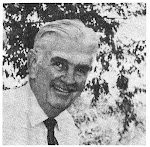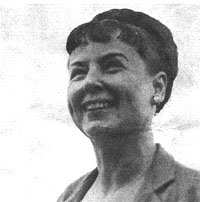 Holling and Lucille
Holling and Lucille
Okay, no one talked me into it, but here's the rest of Holling's interview with this publisher's representative.... Ms. Montgomery’s pre-publication queries subsequently delved deeply into Holling’s biography and character, almost to the point of embarrassment.
Dear
Mrs. Montgomery:
Just
returned from the east, hence the delay in answering you[r] last letter.
The
story on "PADDLE" reads very well, and your title "RETURNED WITH
INTEREST" is excellent.
It
has been fun working with you. Be sure to have your publishers ship me a copy of
the book when it comes out.
Good
luck, and happy sale-ing!
Yours
sincerely,
Holling
P.S.Am
enclosing a few shots on signatures to used at will.
My
preferences might be No. 1 or 4.
Paddle-to-the-Sea
Published
by: Houghton Mifflin Co. Year: 1941
Real
Name: Born Holling Alison Clancy. Father
died in 1918. Because the Clancy line was extended by innumerable cousins,
while the Holling line ended with my mother, I added
another
"Holling" to my name for books. To save confusion, the name was legalized
and I am now known as Holling Clancy Holling, but old friends still recognize
me as being the original Holling Clancy.
What
do your family and friends call you?: Holling
A.
YOUR BACKGROUND
Date
of birth: Aug 2-1900 Place of birth:
Grandfather Holling's Farm, Henrietta Township, Jackson Co.
Father's
occupation: School Supt. Number of Brothers: 1 and sisters: 1
Father's
nationality: Canadian Irish-French in Canada for 2 centuries
Mother's
nationality: American--English stock, mother's grandfather direct
from
England
Kind
of home during childhood (farm, small town, city apt. etc):
Childhood,
North Mich. S. Peninsula. Small towns with fairly large high schools
Adolescence
on the Holling Farm
Where:
Westbranch, and AuSable, Mich. 2 yrs. after leaving AuSable
it
was destroyed by forest fire.
Amount
of schooling (high school, college, etc.): Graduate Leslie High Sch., Leslie
Mich.
Grad.
Art Institute, Chicago. Special tutoring Anthropology
Economic
status during childhood (poor, middle class, wealthy): Middle
Special
interests as a child (sports, books, games, etc.): Father was good horseman.
Learned
to ride young - I had a pony.
Father
inducted me into mysteries of natural sciences - hence love of woods, books.
Mother
was pianist, wrote verse, plays etc. locally. Hence love of art, music etc.
Childhood
ambitions: To own and control a circus
To
write and illustrate books
When
did you begin to write?: First- drawing, pig with litter at 3
First
verse (local paper) at 5 - ever anon!
Why?:
Natural expression. Each new experience I documented in drawn pictures.
Who
encouraged you?: Mother, Father, assorted relatives. Father's brothers and
sisters were missionaries in India, Africa. Visits home gave me much food for
imagination.
What
and when was your first success or recognition: Difficult to determine as I
grew into it. Mother wrote and produced plays and musicals for Father's schools
and I was in them. First actual publications were in boy's magazines as youngster.
Verse in adult mag. etc. First books - See Oct. Supplement: Who's Who in Am.; 1942
How
did you happen to write for children?: Grew
into this phase also. An intense interest in hows and whys of life gave me an
interpreter complex: suppose you could say that I wanted to know how a thing was
done so that I could pass it on to others. Regard myself as an interpreter.
Anything
else about your background which has a bearing on your writing.:
From
small-town-farm environment graduated to big city env. (Chicago) but I was
still the "Wilderness-lover." A year in the deserts of New Mexico helped.
Also,
working on scientific staff (Taxidermist Asst) of Field Museum of
Nat.
Hist., Chicago gave me great impetus. Field trips, Montana and British Columbia
for specimens. One real turning point was meeting of Dr. Ralph Linton, Head of American
Ethnology Dept. at the museum. We struck up a bargain and after a day's work in
Zoology, Dr. Linton (in his office) gave me from one to 3 hours lecture in
Anthropology. He tried out his courses on me. (He was later at Columbia Un,,
now at Yale). A couple of years of this gave me a foundation in the study of
Man - past, present and possible future Which acted as a key or an entire filing system in my
brain for the correlation of scattered information. Hence, any information now
gleaned has its pigeon-hole in my mind and becomes part of a subconscious fund available for future books.
(I plan to Produce Bushels!)
P.S.
Look at designs on title contents page, map etc. of "Paddle" and you
will see patterns in birch bark as related below - (though of course not in old Chippewa design).
B.
THE WRITING OF THE BOOK
Where
did you get the idea for the book?: Touring the Gulf States, Lowell Thompson of
H.M.Co. [Houghton Mifflin] wrote me about illustrating a book for them. At
Boston I gave Lowell various ideas for books. He liked the idea of a story
about a river. So Mrs. Holling and I started west again in our studio-trailer
for the headwaters of the Missouri. En route, Wisconsin and Minn., idea shifted
to a river in the Great Lakes.
When
(Season as well as year): Autumn 1938
On
a fishing boat in Lake Superior I said "that's it - a chip floats along the
river in the Lakes, clear to the sea." Later that month, Lucille (Mrs. H.)
and I met a Chippewa woman selling birch bark baskets near Fort William Ont.
She used hideous designs from magazines- flower pots, sunbonnet babies, roses
etc. We said "why not use the original Chippewa designs but tho her
mother had remembered then, she had
forgotten. So Lucille and I at Fort William Camp, from memory, cut out many
birch patterns of Chippewa and Cree designs. These I did on the orange-colored tree-side
of the bark, traced with a point and all inside the outline scraped neatly. This
gives a darker silhouette on the dark bark. The woman was astonished at the
authentic designs and because we even cut them in bark patterns, like the
old-time Chippeway. To show her gratitude and pleasure she gave us, among other
things, a carving made by a 12-year old
Chippewa friend. We still have it - a kneeling Indian with drawn bow. If a 12
yr. old could do this, I reasoned, then an Indian in a canoe would be easy. So
there was my `chip' to float thru the `river' in the Lakes' to the sea. My high
school summer vacations had been spent
(2 years) working on Great Lakes freighters. Lucille and I had camped all
around the Lakes on long canoe trips, including Nipiquo country. So the story virtually
developed on its own, as naturally as a chip going downstream. The title came
while we camped in Bryce Canyon, Utah. I thought of having the boy carve
"I am Paddle-to- the-Sea" ____ verbal thing - as an Indian would say
"I am Paddling to the sea! But the words seemed simple and direct, and the
title was born as is.
When
did you begin to write the book?: 1939
Where?:
Sequoia Park, Calf. extending to Olympic Pen. (Neah Bay region) finished
Altadena Calf.
My
desert books are often written in canoes, canoeing books in deserts. Perspective,
you see.
How
much had you had published when you began it? (Give names of books) See
"Who's Who, Oct sup., 1942" page 208 - also "Story and Verse for
Children" - page 813 by Miriam Blanton Huber
What
was your purpose in writing this book?: To give youngsters a taste of the North
Country I knew - to have fun making a
book - and for cash!
How
do you write? (typewriter, long-hand, dictate):
Where?
(study, office, etc.):
Do
you keep regular office hours?: Yes. If so, what are they?: No
Do
you revise much?: Yes Write easily or
laboriously?: It all depends
Do
you let your family or friends read your work, or try it out on children?: Read
it to my wife. Never to children.
Who makes your final copies? (yourself,
private secretary, public typist, etc.): or sometimes to save time typist.
Did
you make an outline before writing the book?: No
Did
you decide on the title first or last?: First
How
long did it take you to write the book?: Problematical. Some paragraphs rewritten
60 times for simplicity and rhythm [sic].
Did
you work on it steadily?: At times.
Did
it go fairly smoothly or did you hit rough spots? (Details of any particular
difficulty and its solution would be appreciated.): No rough spots in story proper. Sometimes difficult to choose
which writing told story best. In PADDLE, TREE and new book SEABIRD, each page
of some 300 words is a complete chapter. This
necessitates work in framing all ideas for that page simply and yet
without losing the plot, excitement, etc. (As against such writing, sonnets are
a cinch!)
Was
your book accepted immediately by a publisher?: Yes
Was
it immediately popular on publication?: Thank Heaven!
Anything
else about your writing that might be of interest, especially anything that
concerns this book.: The rests between spurts were swell!
C.
ILLUSTRATIONS
How
much did you have to do with the illustrations of your book?: Practically
everything except making the plates.
If
you did them yourself, which came first, the pictures or the text?: Text
What
medium did you work in?: Water-color, pencil, pen
How
much experience had you had in illustrating?: years.
D. WHAT SORT OF PERSON YOU ARE
What
did you look like when you wrote this book? Dark or Fair?: Dark
Tall
or short?: 5' 10-1/2"
Thin
or plump?: Slender
Color
of eyes?: Dark blue Wore glasses?: No
Color
of hair?: Dark Brown Kind of hair--long
or short?: Medium
Curly
or straight?: Straight How did you wear
it?: See picture
Any
special features of your appearance (square jaw, dimples, stoop,etc.): Would
dearly love a square jaw but haven't one. No dimples. No s
toop.
Are
you quiet or talkative?: It all depends.
Friendly or reserved?: Ditto
Do
you laugh a great deal or are you usually grave?: Not manic-depressive. However,
can howl with glee or be sober as hell.
Are
you quick-tempered or calm and placid?: Every alternate leap-year.
What
sort of clothes do you wear most when
writing? (sports, suits slacks, etc.): Sometimes trunks only. Sometimes
overcoats. Altitude and weather dictate.
Favorite
occupations and hobbies?: Too many
What
is your normal speech like? (Meticulously correct, colloquial, slangy, abrupt,
rambling, etc.): Yes. And the shadings can be subtle.
What
are some of your pet expressions and exclamations?: I blush.
Profanity
not habitual.
If
strongly religious, give denomination.: Brought up a Methodist - but am very
broad in view. Could still be called Christian.
Any
other details about yourself, no matter how trivial, which might help me to picture you in my own mind.
Latin Americans call me "simpatico." I become with no effort the age
to which I am talking. Even some dogs seem to wonder why I have no tail. Cats
regard me with favor. Also old people. Also my wife (this statement - should be
qualified at length.
Can
you direct me to any articles or books which have been written about you?: See
Who's Who Supplement for Oct. 1942. It contains
most complete list of my books.
If
you have a photograph or snapshot of
yourself of about the vintage of your book, I would appreciate it. Of course I
would return it promptly. Please keep the thing!














